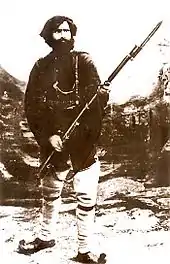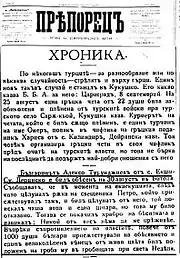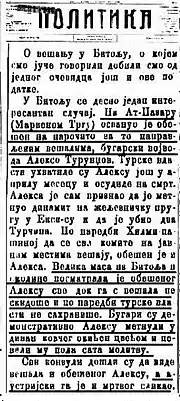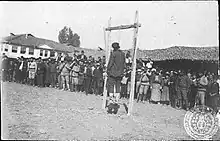Aleksandar Turundzhev
Aleksandar Kicev Turundzhev (Bulgarian: Александър Кичев Турунджев; Macedonian: Александар Турунџев) was a Bulgarian revolutionary from Ottoman Macedonia and leader of the Lerin cheta of the Internal Macedonian Adrianople Revolutionary Organization. According to the post-WWII Macedonian historiography, he was an ethnic Macedonian.[1]

Biography

He was born in 1872 in the village of Gorno Varbeni in Monastir Vilayet (today Xino Nero in Amyntaio, Greece). He joined the IMARO while he was young as a rebel and took part in terrorist operations. Starting in 1902 he was under the command of the Bulgarian officer Georgi Papanchev, but after his death in May, by June 1903 he becomes a voyvoda of the cheta in Florina.
In the time of the Ilinden Uprising he played a big part in the battles in the territory around Lerin. During all the years of illegal residence and movement, Turundzhev regularly surrounded the villages in Lerin and some in Lower Prespa and Bitola.
Ilinden–Preobrazhenie Uprising
After the decision to begin a rebellion on the Salonica Congress of IMARO and its confirmation on the Smilevo Congress, Turundzhev was given the task to organize his own village and prepare it for the uprising.
When finished with the military training of his fellow villagers of all ages, but mostly aged 20–25 years, Turundzhev with all of them, about 230 people, made a training, organized several Thalia (maneuver) with that in the improvised clashes between insurgents. During the Ilinden Uprising in Lerin was fulfilled the directive given on the Smilevo Congress for guerrilla mode of warfare. Turundzhev mobilized a total of 500 fighters, with including 100 rebels from his native village.

Ottoman commanders drafted a detailed plan of the counteroffensive against Macedono-Bulgarian revolutionary, rebel units.[2] To stop the uprising, the vilayet authorities made a decision to accommodate a new unit in the village of Turundzhev on 14 November 1903.
The presence of the Ottoman units did not scare the IMRO members of Ekshi su, and it didn't srop the organization's activity of Turundzhev, who began a reconstruction of the revolutionary net in his region.[3]
Death

On the end of 1904 he was betrayed by Mitre Ginkov in the village of Aetos. He was captured and taken to the Turkish court in Bitola, where he was sentenced to death. His punishment was done in public, on 29 August 1905 in front of Bitola's At-bazaar he is killed with hanging. According to the British Consul in Thessaloniki, Robert Graves, the same day several thousand citizens followed the coffin, which was covered with wreaths from the Bulgarian Church congregation.[4] His grave is in the cemeteries Saint Nedela in Bitola.[5]
References
- The first name of the IMRO was "Bulgarian Macedonian-Adrianople Revolutionary Committees", which was later changed several times. Initially its membership was restricted only for Bulgarians. It was active not only in Macedonia but also in Thrace (the Vilayet of Adrianople). Since its early name emphasized the Bulgarian nature of the organization by linking the inhabitants of Thrace and Macedonia to Bulgaria, these facts are still difficult to be explained from the Macedonian historiography. They suggest that IMRO revolutionaries in the Ottoman period did not differentiate between ‘Macedonians’ and ‘Bulgarians’. Moreover, as their own writings attest, they often saw themselves and their compatriots as ‘Bulgarians’ and wrote in Bulgarian standard language. For more see: Brunnbauer, Ulf (2004) Historiography, Myths and the Nation in the Republic of Macedonia. In: Brunnbauer, Ulf, (ed.) (Re)Writing History. Historiography in Southeast Europe after Socialism. Studies on South East Europe, vol. 4. LIT, Münster, pp. 165-200 ISBN 382587365X.
- "Correspondence of Daily telegraph concerning the fights during the first days of Ilinden-Preobrazhenie Uprising, Thessalonica, 13 August 1903". Archived from the original on 3 March 2016. Retrieved 11 November 2012.
- Николов, Борис Й. Вътрешна македоно-одринска революционна организация. Войводи и ръководители (1893-1934). Биографично-библиографски справочник, София, 2001., стр.172.
- Весник Его, бр. 280, 2 Јуни 2011 г. Битола ја познавам, во Битола никого не познавам! Автор: Здравко Божиновски.
- Куманов, Милен. „Македония. Кратък исторически справочник“, София, 1993.
